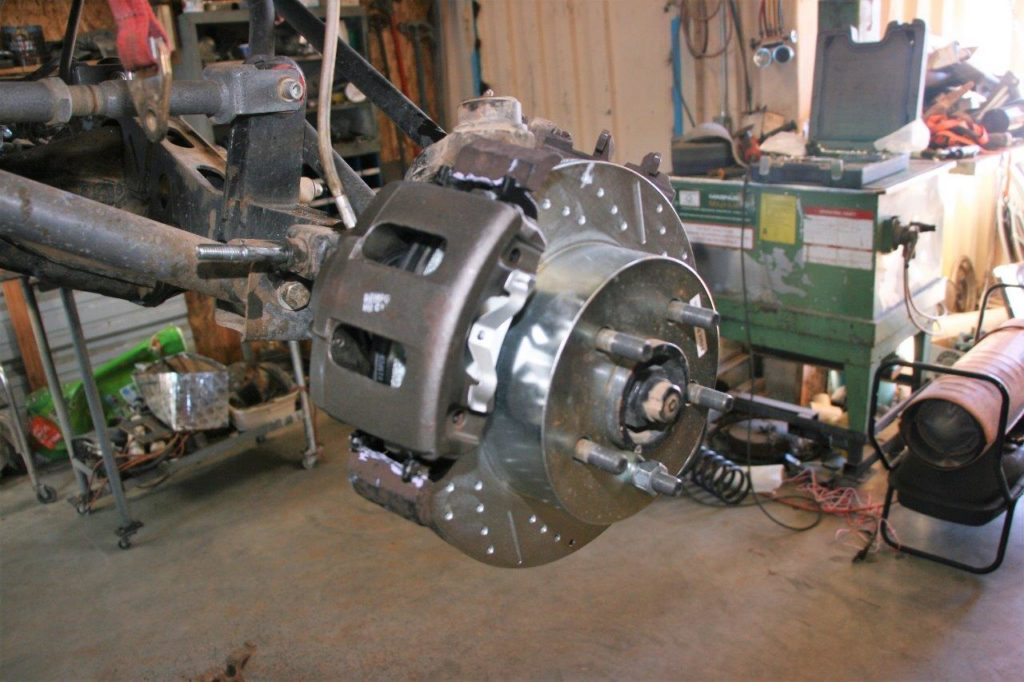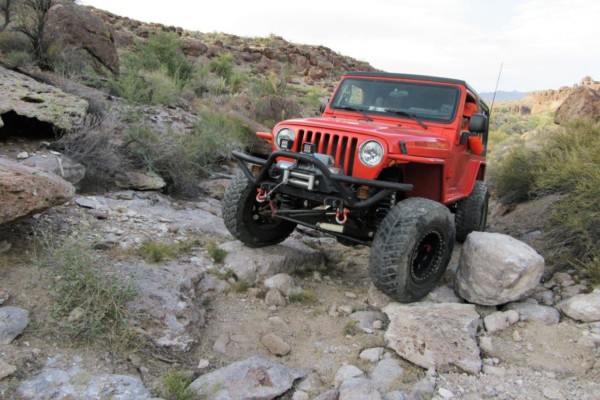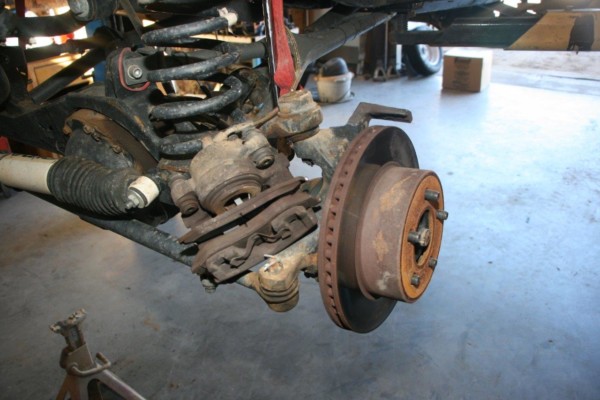You’ve increased your Jeep’s tire size for improved ground clearance, and then you lowered its gear ratio to take advantage of the taller tires.
But now, with the taller tires and lower gears, you feel a significant decline in stopping power. That’s because the heavier tires require better brakes to slow and stop them.
Generally, any tire taller than a Rubicon’s original 32-inch-diameter tire needs an improved braking system. That means if you upgrade your OEM tires (2005 Rubicon, LT245/75R16, 31-inch diameter), the size and weight of the larger tires also requires a brake upgrade. One good option might be these Power Stop front brake kits (K2152-36) and rear (K2197-36) kits with new drilled and slotted rotors and brake pads.
While some folks say drilled and slotted rotors may have more problems in mud than the flat OEM-style rotors, we think the added cooling and drying provided by the holes and slots are well worth it, especially when towing a camping trailer in heavy traffic or off-road. Just remember to clean them after any deep mud adventures.
All Wrangler-style Jeeps have been equipped with front disc brakes since the CJ7 was introduced in 1976. When Jeep engineers developed the Rubicon, one of the upgrades from a standard Wrangler included disc brakes on all four corners. Due to their design, drum brakes can overheat quickly and lose their stopping power, but disc brakes rarely overheat in non-racing conditions. Disc brakes are designed to cool off rapidly.
Disc brakes provide better stopping power, making them the better choice over drum brakes for virtually any style of driving.
This article will give you an overall look at what it takes to swap in new calipers, rotors, and pads. We’ll also show you how to maintain your braking system, and how to service it.
Bleeding the Brakes
Whenever the hydraulic system is opened—except for removing the master cylinder’s top to check the fluid level—you need to bleed the brakes. If you have replaced your brake pads recently—and notice a spongy feel when the brakes are engaged—you should consider bleeding your brake system just to be careful. If the brake-fluid level drops too low in the master cylinder reservoir, air bubbles can get caught in the lines, and reducing the overall strength of the brake fluid column, you need to bleed the brakes. This process gets all the air out of the brake fluid system and restores the hydraulic brakes to full strength.
Below are the typical steps to brake bleeding:
- Remove the top of the master cylinder reservoir.
- If the fluid is murky and not clear, you need to get it out and replace it. Using a clean turkey baster (it’s like a huge eye dropper), suck out as much of the old fluid as you can.
- After you’ve gotten the old brake fluid out, clean out any sediment from the reservoir, if accessible, with a clean, lint-free rag and brake cleaner spray. Do not spill brake fluid on any painted surfaces as it will remove the paint almost immediately.
- Fill the master cylinder with clean brake fluid and replace the top.
- Have an assistant pump the brake pedal several times (10 or more).
- Using a box-end wrench (often 10mm on Jeeps) that fits the bleeder bolt, loosen each bleeder valve in turn, starting with the brake furthest from the master cylinder—in the USA, that’ll be the right rear.
- Many people, especially professionals, will slide a tube over the bleeder bolt, but most of us just leave it exposed. Using a piece of clear plastic tubing (surgical or aquarium tubing works fine), place the other end in a bottle that you can discard.
- Refill the master cylinder reservoir with fresh fluid. Keep the master cylinder full during the bleed process, otherwise air might get into system, and replace the top.
- Have the assistant pump the brake pedal twice and keep it pressed down.
- Starting with the rear passenger wheel, turn the bleeder bolt to the left one quarter-turn. Old fluid and air will be expelled. When the fluid stops, close the bleeder valve and ask your assistant to pump the brake pedal.
- After your assistant pumps twice and holds down the pedal, you can release the bleeder.
- Repeat this process until new, clear fluid emerges from the bleeder tube. After each wheel or after every five times the brake pedal is depressed, top off the master cylinder reservoir with fresh fluid. Never let the reservoir get too low, or air will be sucked into the master cylinder.
- Repeat this process at each wheel, moving closer to the master cylinder each time, and ending with the driver’s side front wheel.
- When finished, top off the master cylinder one last time.
Keep in mind, there are also one-man bleeding kits available that can make brake bleeding a solo job.
Breaking in the Brakes
Anytime you install new brake rotors, brake pads, or both, it’s advantageous to break in or “bed in” your new brakes. Bedding in your brakes helps transfer an even layer of brake pad material onto the brake rotor, which assists in smoother brake operation and improved braking power. Having a uniform layer of pad material on the brake rotor is essential to minimizing brake squeal and vibration. For this procedure, you will need a good stretch of road and no traffic. Be safe when you do this and use common sense.
- Accelerate to 45 miles-per-hour (mph) and perform three or four medium stops. A medium stop is slightly more aggressive than normal braking, and you don’t need to come to a complete stop for each run. This brings the brake rotors up to temperature so they are not exposed to sudden thermal shock.
- Next, accelerate to 60 mile-per-hour and make eight to ten more aggressive brake applications to pull the Jeep down to 15 miles-per-hour. For this series, you want to be firm and aggressive, but not to the point where ABS (if equipped) activates and/or the wheels lock up. It’s important to note that you don’t come to a complete stop but rather a semi-stop (about 15 miles-per-hour). Accelerate quickly back up to 60 miles-per-hour as soon as you slowed down to your semi-stop.
Some Jeeps may require two cycles of the bedding-in procedure. This may be the case if you are using old brake rotors with new brake pads, or new brake rotors with old pads. This may also be the case if you don’t think you fully heated up the brakes in the initial bedding procedure. In any case, wait at least 10-15 minutes between each cycle as you don’t want them to overlap.
After the break-in procedure, there may be a light blue tint on your brake rotors as well as a gray film deposit. The blue tint shows that your rotor has reached the appropriate temperature during the bedding process, and the gray film is some of the pad transfer material.
Adjusting the Parking Brake
If your Jeep’s parking brake isn’t holding, your problem lies in the adjustment of the drum brakes that serve as the parking brake inside of the rear rotors. There are adjuster ports on the inside of the backing plates of the rear rotors.
- Remove the rubber plug and use a brake adjusting spoon, the same kind used for adjusting drum brakes (you can also use a flat-blade screwdriver).
- With the rear wheel suspended, adjust until you feel a slight drag from the brakes on the wheel when rotating it by hand.
- Repeat the process for the other side.
Check out the slideshow below for an overview of the installation process:















Thanks for your helpful information, Really admire you, when you can build such Jeeps. Drive the cars created by yourself on rough roads, interesting